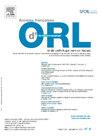再版:解剖残余与鼻窦翻修手术的相关性
Q4 Medicine
Annales Francaises d''Oto-Rhino-Laryngologie et de Pathologie Cervico-Faciale
Pub Date : 2025-03-26
DOI:10.1016/j.aforl.2025.03.002
引用次数: 0
摘要
目的回顾研究慢性鼻窦炎(CRS)患者解剖结构残留如何影响手术结果的科学文献,提供鼻窦内窥镜手术(ESS)后解剖结构残留频率的信息。材料和方法本综述按照SWiM指南的建议进行报道。PubMed、Cochrane Library、Embase和Web of Science被检索到2024年4月。选择用于系统评价的研究使用牛津循证医学证据水平和STROBE对质量和偏倚风险进行了评估。根据EPOS和ICAR指南对结果进行描述性和定性分析。结果14项相关研究符合定性综合纳入标准。包括前瞻性和回顾性横断面设计,重点是修订ESS。4项研究检查了全院功能性ESS (FESS), 3项研究关注额窦手术,4项研究关注传统FESS, 3项研究没有明确手术类型。对偏倚风险进行了评估,发现研究质量存在显著差异,证据水平较低。ESS术后保留的解剖结构存在很大的差异,其中尤以保留钩突(29.6-64%)、鼻塞细胞(4.5-83.33%)和额筛细胞(40.7-96.8%)最为显著。对甲壳大疱、鼻中隔偏曲和中鼻甲偏侧的观察显示,在纳入的研究中有不同的模式。结论本系统综述强调了CRS翻修手术中解剖结构切除不完全的持续挑战。关键结构保留的可变性突出了手术结果的复杂性和进一步改进手术技术的必要性。本文章由计算机程序翻译,如有差异,请以英文原文为准。
Republication de : Relevance of anatomical remnants for revision sinus surgery
Objectives
Review of the scientific literature dedicated to investigating how residual structures impact surgical outcomes in chronic rhinosinusitis (CRS) patients, providing information on the frequency of anatomical remnants after endoscopic sinus surgery (ESS).
Material and methods
This review has been reported following the recommendations of the SWiM guideline. PubMed, Cochrane Library, Embase, and Web of Science were searched until April 2024. Studies selected for the systematic review were assessed about quality and risk of bias using the Oxford Centre for Evidence-Based Medicine Levels of Evidence and STROBE. The findings were analyzed descriptively and qualitatively, aligning with EPOS and ICAR guidelines.
Results
Fourteen relevant studies met the inclusion criteria for qualitative synthesis. Prospective and retrospective cross-sectional designs, focusing on revision ESS, were included. Four studies examined full-house functional ESS (FESS), three focused on frontal sinus surgery, four on conventional FESS and three did not specify the surgery type. The risk of bias was assessed, revealing significant variability in study quality and a low level of evidence. Wide variability was found in anatomical structures remaining after ESS, most notably in retained uncinate process (29.6–64%), agger nasi cell (4.5–83.33%) and frontoethmoidal cells (40.7–96.8%). Observations on concha bullosa, septal deviation and lateralization of the middle turbinate revealed distinct patterns among the included studies.
Conclusion
This systematic review underscores the persistent challenge of incomplete resection of anatomical structures in revision surgeries for CRS. The variability in the retention of key structures highlights the complexity of surgical outcomes and the need for further refinement in surgical techniques.
求助全文
通过发布文献求助,成功后即可免费获取论文全文。
去求助
来源期刊

Annales Francaises d''Oto-Rhino-Laryngologie et de Pathologie Cervico-Faciale
Medicine-Otorhinolaryngology
CiteScore
0.10
自引率
0.00%
发文量
93
审稿时长
51 days
 求助内容:
求助内容: 应助结果提醒方式:
应助结果提醒方式:


